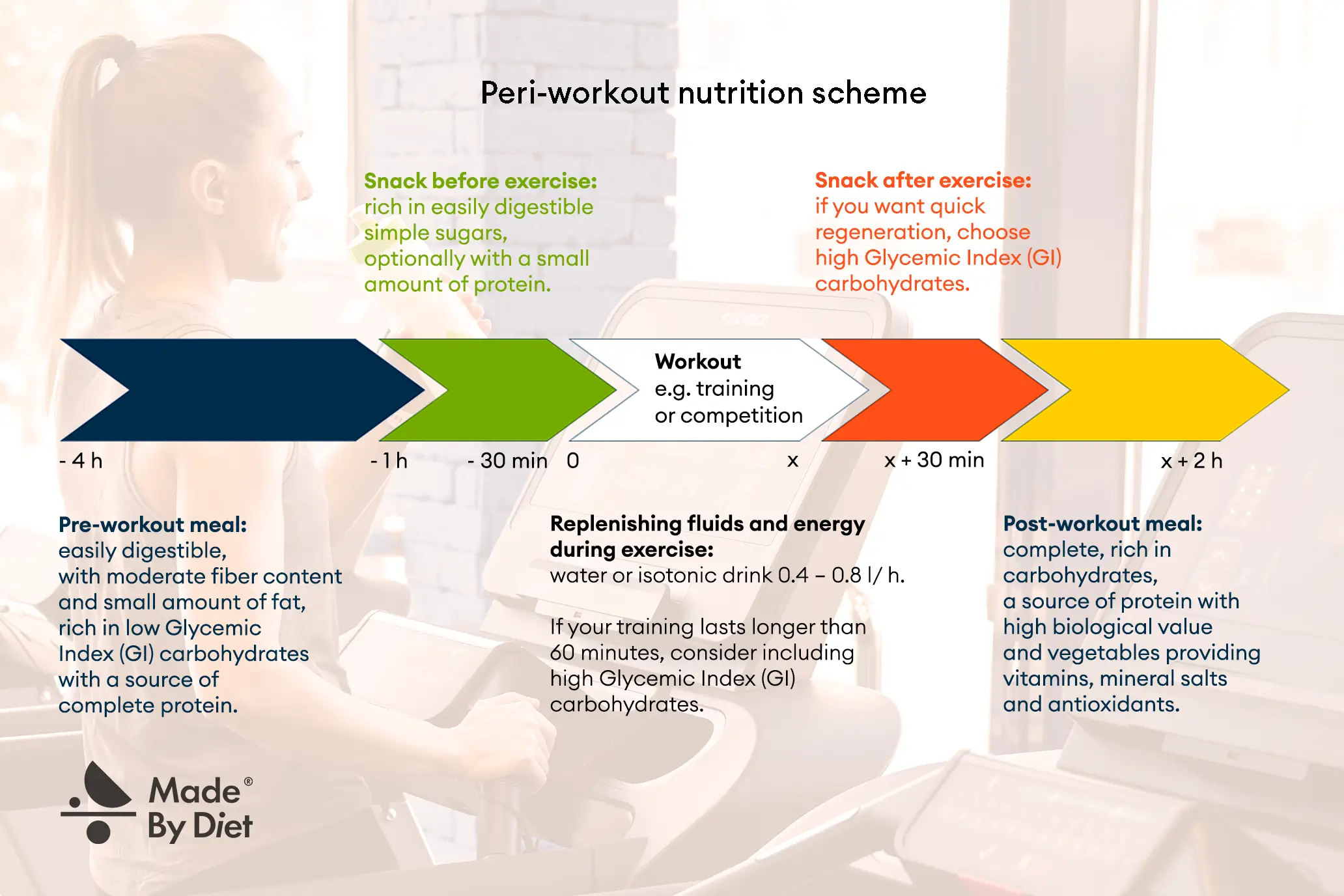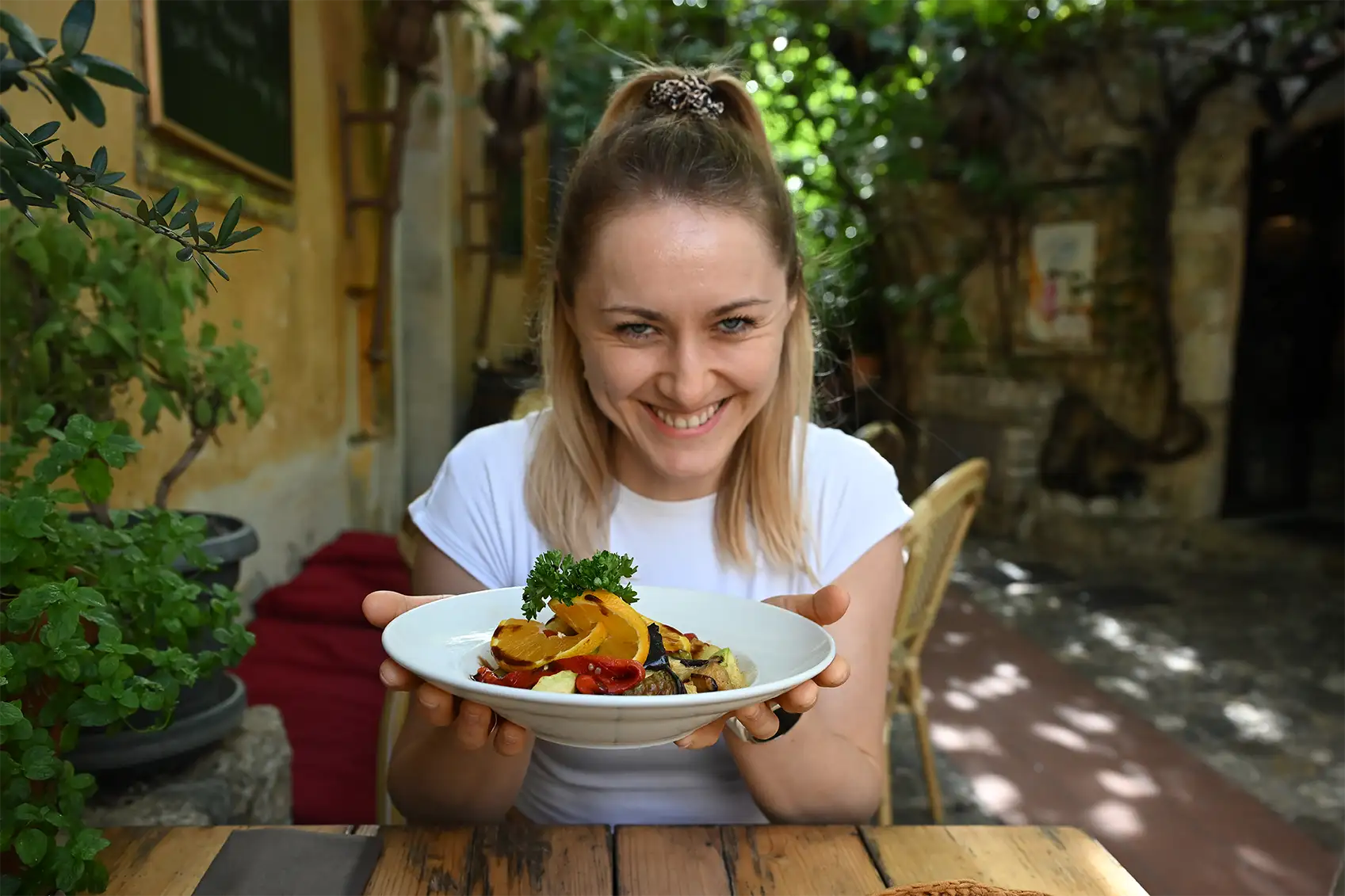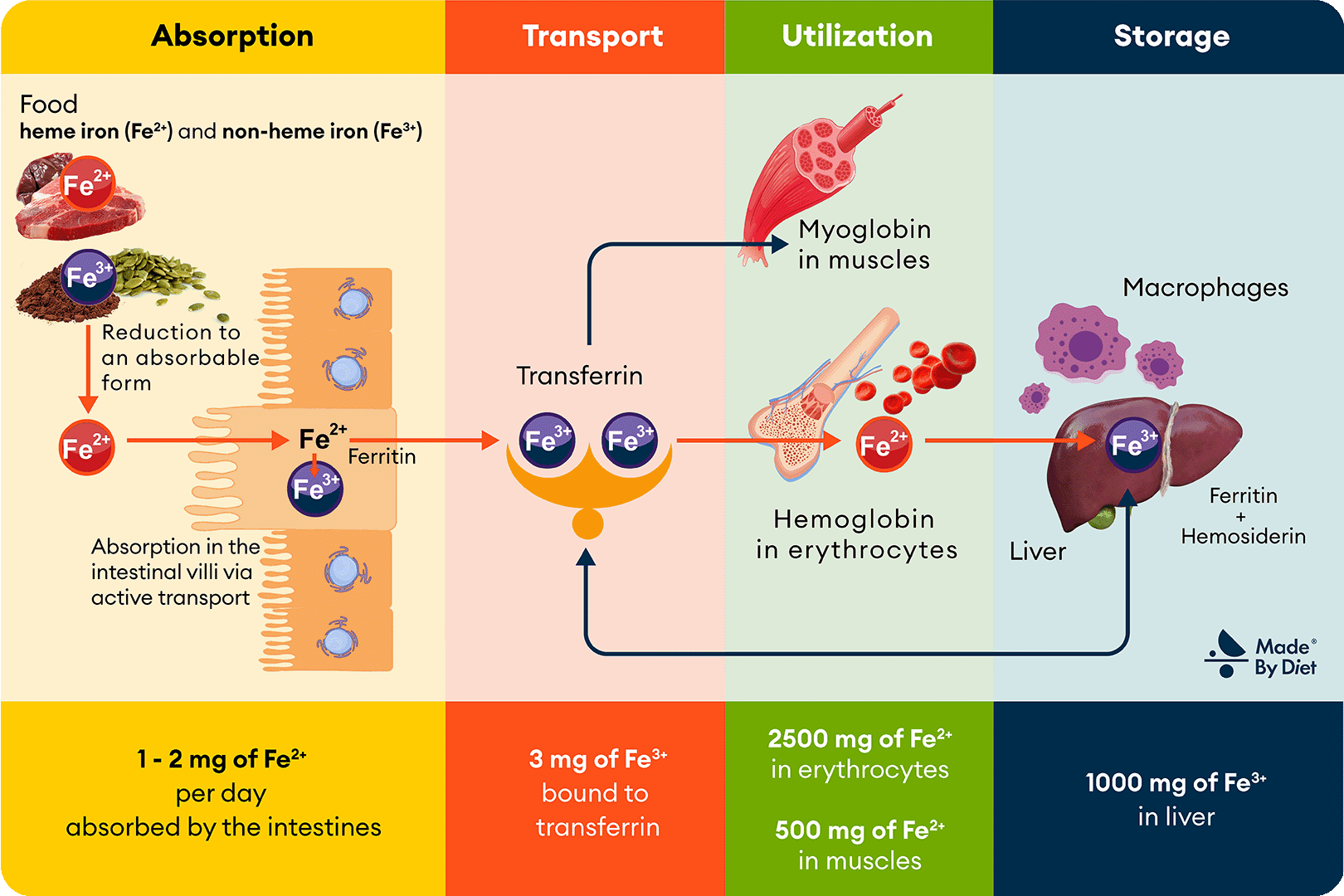To eat, or not to eat? That is the question…that you often ask yourself before your workout. On the one hand, you don’t want to be knocked out by hunger and a rapid drop in energy during workout, but on the other hand, you also don’t want to feel heavy and sluggish. You’ve also probably heard of people who run on an empty stomach to lose weight faster… What should you choose to achieve the workout results you hope for, or your best performance at competitions, and at the same time maintain your well-being?
Authors: Klaudia Buczek, MSc Eng., and Michał Miśta, MSc Pharm.
Contents
- The most common mistakes when eating before training
- The goals of pre-workout nutrition
- Carbohydrates before training
- Glycemic index – what is it and how does it translate into training effevtiveness?
- Hypoglycemia – what is it, symptoms, how to avoid it?
- Pre-workout meal and gastrointestinal discomfort
- Pre-workout meal timing
- Protein before training
- Fats before training – an inexhaustible source of fuel?
- Pre-workout hydration
- Summary – how and when to eat before training – tips
The most common mistakes when eating before training
To begin with, you need to realize that it takes no less than 2 or 3 hours to digest, absorb and metabolize food. Foods which are difficult to digest, such as fatty meats, mushrooms, legumes (beans, peas, lentils, chickpeas, broad beans), smoked and canned fish (tuna in oil) or cream-based cakes can literally stay in the stomach for hours! Being aware of this will help you avoid two basic mistakes:
1. Avoid products are often very hard on the stomach in your pre-workout meals.
Before exercise, the foods which are difficult to digest should be avoided at all costs in favor of easily digestible (low-fat and moderate-fiber) meals that provide you with a natural energy boost, especially carbohydrates (as we discuss it in more detail below).
2. There is no point in eating a full meal immediately before your workout
Consuming an abundant meal activates the parasympathetic part of your autonomic nervous system, which is responsible for relaxation, rest, increased blood flow through the gastrointestinal tract area, pancreas and liver, higher secretion of saliva, gastric juice, bile, insulin, but also slower heart rate and bronchoconstriction. This will make you feel tired and drowsy soon after the meal. These physiological reactions are exactly the opposite to what you want to achieve during your workout! If you work out immediately after eating a hearty meal, you won’t be able to use up the calories you have just consumed. Obviously, a full belly can be pretty uncomfortable when you exercise.
However, this does not mean that you should skip the pre-workout meal! If your body doesn’t get energy from food, you risk losing your muscle mass, decreased energy levels and poorer performance during the workout! If your goal is to lose weight, you don’t have to exercise with an empty stomach to accomplish this goal! All you need is an energy deficit during the day which will fit your individual needs. According to research, no change in fat loss was observed between individuals who exercised without or after a meal.
A pre-exercise meal that is properly balanced and consumed with the optimal timing will help you achieve better athletic performance, especially if you plan to work out longer.
The goals of pre-workout nutrition
The main goal of your pre-workout nutritional strategy is to stay hydrated, to replenish glycogen in your muscles and liver, and prepare the body for increased demand for energy. It is also important to keep your gastrointestinal comfort.
A proper pre-workout nutrition and hydration strategy is particularly important in the following cases:
- prolonged physical activity (for workouts that last more than 60 minutes)
- high-intensity training
- exertion in high ambient temperature
- limitations in the supply of energy and fluids during exercise
- propensity for hypoglycemia
- a history of gastrointestinal discomforts.
Carbohydrates before training
Carbohydrates are the main source of energy during high-intensity training, both anaerobic and aerobic. Carbohydrates can be quickly used by your body for energy so you can exercise long and hard. Make room for carbohydrates on your plate before the workout, and you will benefit from improved endurance of your muscles and the nervous system, better performance and increased concentration.
If you exercise, eat 1 to 4 grams of carbohydrase per kilogram of body weight 1-4 hours before the workout. Feel free to adapt these recommendations to your individual needs and preferences, and your gastrointestinal function. A diet rich in carbohydrates is especially recommended for endurance sports (running, cycling, triathlon) or those in which the supply of carbohydrate is crucial to maintain high intensity levels of your training (team and racquet sports).
Glycemic index – what is it and how does it translate into training effevtiveness?
Foods rich in carbohydrates differ in how quickly the blood sugar (glucose) levels rise when a particular food is eaten. Glycemic Index (GI) is a rating system of blood glucose increase within 2 hours after consuming a specific amount of a product containing 50 grams of available carbohydrates. The general perception is that simple sugars cause a sudden but short rise in blood glucose levels, while complex carbohydrates provide stable glycemia. This claim is not entirely true. To provide an example, fructose, a simple sugar contained in fruits, causes a gradual rise in blood glucose levels and has a low GI. When choosing your meals, use a table of glycemic indexes (GIs).
Is the GI of pre-workout meals important? According to research, it is more beneficial to choose products with a low glycemic index to perform better during a workout, especially during long-term endurance activities. This applies specifically to the sports activities where you have a limited ability to supply your body with carbohydrates during the exercise. If you can eat snacks when you exercise, meal selection based on the glycemic index has a negligible effect on your performance. However, we do recommend products with low or moderate GI to help your body maintain stable blood glucose levels (euglycemia).
Hypoglycemia – what is it, symptoms, how to avoid it?
Do you sometimes feel a sudden plunge in energy after starting a workout? This can be caused by a sudden drop in blood glucose levels, or hypoglycemia. There are two main factors that can contribute to this condition: a pre-workout meal high in carbohydrates, which leads to excessive insulin release, or the easier uptake of glucose by muscle cells after the start of the workout.
Some people may experience symptoms such as fatigue, decreased concentration and dizziness. These symptoms usually subside after some time and usually do not affect your performance, but they can be unpleasant, especially if you are a beginner, to the point that you may feel discouraged and discontinue your workout.
To avoid hypoglycemia, a slightly reduced intake of carbohydrates before the workout is recommended (about 1 g/kg body weight). You should also choose foods with a low glycemic index, which will promote euglycemia. Try different meal times to find the timing that is best for you. It is generally believed that the risk of hypoglycemia is the highest if you consume a meal rich in carbohydrates 45-75 minutes before your workout. If you are prone to hypoglycemia, try to avoid eating lots of carbohydrates during this time window. Rather, choose a carbohydrate snack that you consume immediately before your workout. You can also eat sugars during the workout – a sports drink is a perfect choice.
Pre-workout meal and gastrointestinal discomfort
Some active people experience gastrointestinal discomforts during or after a workout. Competitive stress can make such discomforts worse. If you experience gastrointestinal problems before during or after a workout, or you are likely to suffer from this condition, limit the amount of fat and fiber in your meal as these nutrients slow down digestion. It is also important to reduce the amount of products rich in FODMAPs, which is an acronym that stands for: Fermentable Oligosaccharides, Disaccharides, Monosaccharides, and Polyols, as these nutrients absorb water in the small intestine and ferment in the large intestine, which can exacerbate intestinal discomfort.
Liquid or semi-liquid meals can also remedy this problem. This form of meal will also work well for people who experience stress-related lack of appetite.
Pre-workout meal timing
You now know that you should preferably eat a meal no later than 60 minutes and no earlier than 4 hours before your workout. But which variant is better?
A meal 3-4 hours before the workout – this is the perfect timing for a pre-competition meal, especially if you compete in endurance activities, and for those struggling with gastrointestinal discomforts. You should opt for an easily digestible meal rich in complex carbohydrates with a low glycemic index. Your meal should be solid. If you’re facing intense exertion during a competition or if you struggle with gastrointestinal discomforts, reduce the content of dietary fiber in your meal. For example, you can choose basmati rice as a source of carbohydrates. If you plan to exercise for more than 90 minutes, eat an additional carbohydrate snack (a ripe banana, dried fruit or s sports drink) within 30 minutes before your workout.
A meal 2 hours before the workout – this is the best option in the majority of cases, especially if you train regularly. Your meal should preferably be composed of complex carbohydrates and simple carbohydrates in a 1:1 ratio. Reduce the amount of fiber, particularly if you plan to have an intense workout or when you are concerned about possible gastrointestinal discomforts. Your meal should be solid or semi-solid. We recommend a rice meal or an oat meal with an addition of some fresh fruit.
A meal 1 hour before the workout – unless you have the time to eat your meal earlier, this is the last moment for a balanced meal. Your meal should be preferably liquid or semi-liquid and low in food fiber – a smoothie or shake will be a perfect choice. Avoid fiber-rich foods, such as whole-grain cereal products, which prolong the digestion. You should opt for simple sugars, such as fruit.
Protein before training
High-intensity resistance and endurance training increases the secretion of creatine kinase, which is associated with increased muscle catabolism. To protect muscle fibers, it is recommended to consume 0.3 grams of protein per kilogram of body weight no later than 60 minutes before the workout, as long as this amount of protein is well tolerated by your digestive tract. The supply of proteins reduces muscle damage and soreness. Protein should provide your body with all essential amino acids, in the correct proportions, and the best choice is to eat lean meat, fish, eggs, dairy or soy. Vegans can get the essential amino acids from foods, by combining several sources of protein in one meal, such as legumes and cereals.
Fats before training – an inexhaustible source of fuel?
In general, fats are not the best choice for your pre-workout meal as it takes a long time to digest them (as mentioned above); however, obtaining energy from fat oxidation may be an option for some people practicing endurance sports. This is especially true for ultra-endurance exercise. During long but low-intensity exercise (<70% VO2max), the process of fatty acid oxidation prevails, and if you switch your body to get energy from fats, you may be able to extend your workout. Obviously, this does not apply to a single meal, but rather your diet as a whole as your body needs to learn how to use fats for energy. You should pay special attention to products such as avocados, nuts, olive oil, eggs or fatty fish. With a high-fat diet, your body finds it easier to adapt to exercise that continues for a very long time. However, limited exercise intensity is the price you have to pay when choosing a high-fat diet. Some people will improve their performance on a high-fat diet, but for most people, this type of nutrition will be an obstacle rather than a facilitator in boosting their performance. For high-intensity training, preferably choose a high-carb diet.
Pre-workout hydration
You can stay properly hydrated by drinking water and other fluids contained in food. There is plenty of water in fruit and vegetables. If you eat wholesome meals, make room for fruit and vegetables in your diet and hydrate your body regularly throughout the day, you should be sufficiently hydrated before the workout.
However, there are times when the risk of dehydration during workout increases significantly, in which case a proper pre-workout hydration strategy is very important for your well-being, health and performance. Take extra care when:
- you have no or only limited ability to drink fluids during your workout to replace fluid loss from sweating,
- if you are sweating profusely, most often when it is hot.
In these cases, rely on a specific hydration strategy and monitor your hydration. You may use this plan to replenish your body fluids:
4 hours before workout – drink 5-7 ml of fluids per kilogram of body weight.
2 hours before workout – drink 5 ml of fluids per kilogram of body weight, especially if you feel thirsty or if your urine becomes darker.
Directly before your workout – drink additional 300-400 ml of fluids.
To make sure that you start your workout properly hydrated, pay attention to the following:
- thirst
- urine color and volume
- urine specific gravity (if possible)
Based on these factors, you can easily find out whether you have consumed the right amount of fluids or if perhaps you need more. If your urine becomes darker, if you urinate less, or if your urine has a higher specific gravity (> 1.035 g/l) or you simply feel thirsty, make sure to drink more fluids. Hydrate yourself with medium or high mineralized water before the workout. To rehydrate your body quickly, grab an isotonic drink, whose osmolality is similar to that of the fluids of the body, and is quickly absorbed in the intestines and effectively hydrates the body.
You can easily estimate your level of hydration based on the color and volume of your urine. This is especially important during hot weather and high-intensity workout and/or high ambient temperatures. Straw-colored or slightly yellow urine combined with a large volume of urine indicate normal body hydration. The darker your urine, and the less you urinate, the more dehydrated you are.
Summary – how and when to eat before training – tips
Let’s answer the question: to eat or not to eat before training? We hope that the answer is simple – you should definitely eat your pre-workout meal. However, the timing, consistency and composition of your pre-workout meal are highly individual. In order to develop an optimal nutritional strategy, try testing different options and see what works best for you. You can also consult a sports nutritionist to help you choose the optimal nutritional strategy tailored to the type, time and intensity of your physical activity, in addition to your individual preferences.
You may also be interested in:
2025-03-20
How Diet and Lifestyle Affect Your Immunity?
The immune system is indispensable to our survival. Its primary function is to constantly…
2025-02-24
The Mediterranean Diet – Discover the Principles and Foods of the Healthiest Cuisine in the World!
This diet influences not only physical health but also the way we think about food and…
2025-02-07
Iron in the Diet: Iron-Rich Foods, Excess and Deficiency Symptoms
Iron - although present in your body in an amount of only about 4 grams—plays a crucial…
 PL (PLN)
PL (PLN) EN (GBP)
EN (GBP) EN (EUR)
EN (EUR)




